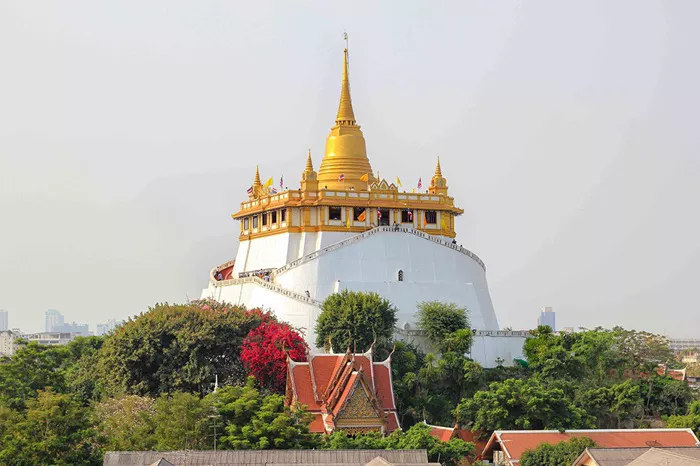Wat Saket, also called the Golden Mount, is one of the most famous Buddhist temples in Bangkok, Thailand. It is well-known for its beautiful golden chedi (stupa) sitting on a man-made hill. Wat Saket holds a special place in Thai culture and Buddhist tradition. Many visitors come here to admire its history, architecture, and peaceful atmosphere.
The History of Wat Saket
Early Foundations
The history of Wat Saket dates back to the Ayutthaya period, before Bangkok became the capital of Thailand. It was originally named Wat Sakae. The temple was built as a simple monastery and grew slowly over time.
The Creation of the Golden Mount
During the reign of King Rama III in the early 19th century, a large project began to build a new chedi over the temple. The king wanted to create a big stupa to house sacred relics of the Buddha. To support this, workers built an artificial hill, one of the few in Bangkok’s mostly flat landscape.
However, the soil was soft, and the structure was unstable. The chedi started to collapse during King Rama IV’s reign. Construction was stopped, and the incomplete chedi was left for many years. It was later covered with earth to form a small hill, which became a landmark in Bangkok.
Completion by King Rama V
In the late 19th century, King Rama V ordered the restoration and completion of the Golden Mount chedi. The chedi was covered with gold tiles, giving it its famous golden appearance today. This project gave Wat Saket a new identity and importance.
Significance of Wat Saket
Religious Importance
Wat Saket is an important Buddhist temple for Thai people. The Golden Mount chedi is believed to house relics of the Buddha, making it a sacred place for worship and meditation. Many pilgrims visit the temple during religious festivals to pay respect and make merit.
Cultural and Historical Value
Besides its religious meaning, Wat Saket has deep cultural and historical significance. It was once used as a cremation ground during a deadly cholera outbreak in the 18th century. The temple’s hill provided a safe and clean place for cremations. This history is remembered with respect and adds a layer of solemnity to the site.
Symbol of Bangkok
The Golden Mount is a famous landmark in Bangkok’s old town. It stands out because of its height and golden color. The temple’s unique location on a hill makes it visible from many parts of the city, symbolizing peace and spirituality amidst urban life.
Temple Architecture of Wat Saket
The Golden Mount Chedi
The most striking feature of Wat Saket is its golden chedi. This large bell-shaped stupa sits on top of the artificial hill. It has a smooth, shiny surface covered with gold leaf. The design follows traditional buddhist architecture styles found in Thailand and other Southeast Asian countries.
The Hill and Staircase
The hill itself is a rare piece of ancient temple architecture adapted to Bangkok’s flat terrain. Visitors climb more than 300 steps to reach the top. Along the way, there are small shrines and statues that add to the temple’s spiritual atmosphere. The climb is considered a form of merit-making for many Buddhists.
Main Temple Buildings
At the base of the hill is the ubosot (ordination hall) and viharn (prayer hall). These buildings have traditional Thai roof styles with intricate wood carvings and golden decorations. Inside, there are Buddha images that worshippers honor with flowers and incense.
Visiting Wat Saket: A Practical Guide
How to Get There
Wat Saket is located in Bangkok’s old city area, near other famous temples like Wat Pho and the Grand Palace. Visitors can take taxis, tuk-tuks, or buses to reach the temple easily. The closest BTS Skytrain station is National Stadium, but it still requires a short taxi ride.
Best Time to Visit
The best time to visit Wat Saket is during the cooler months from November to February. Early morning or late afternoon visits offer comfortable weather and beautiful lighting for photos. The temple is open daily, usually from 9:00 AM to 5:00 PM.
Wat Saket Festival
One of the most famous events at Wat Saket is the Loy Krathong festival, held in November. The Golden Mount is decorated with lights, and many people come to join the candlelight procession. This festival creates a magical and festive atmosphere that attracts both locals and tourists.
What to Expect During the Visit
Visitors should prepare for a moderate climb up the stairs to reach the golden chedi. Along the way, take time to stop at small shrines and enjoy the panoramic views of Bangkok from the top. It is a peaceful place for reflection and prayer.
Remember to dress respectfully, covering shoulders and knees, as Wat Saket is a sacred Buddhist temple. Shoes must be removed before entering indoor halls.
Nearby Attractions
After visiting Wat Saket, travelers can explore nearby cultural spots such as the Grand Palace, Wat Pho, and the vibrant Chinatown area. These places enrich the experience of Bangkok’s rich history and spiritual heritage.
Conclusion
Wat Saket, the Golden Mount, is a must-visit temple for anyone interested in Buddhism, Thai culture, and history. Its unique hilltop chedi, deep historical roots, and religious importance make it a special place. Whether you come for spiritual reasons or sightseeing, Wat Saket offers a serene escape in the heart of bustling Bangkok.
Learning about its history and architecture enhances the visit, helping you appreciate this beautiful example of famous buddhist temples in Thailand.

